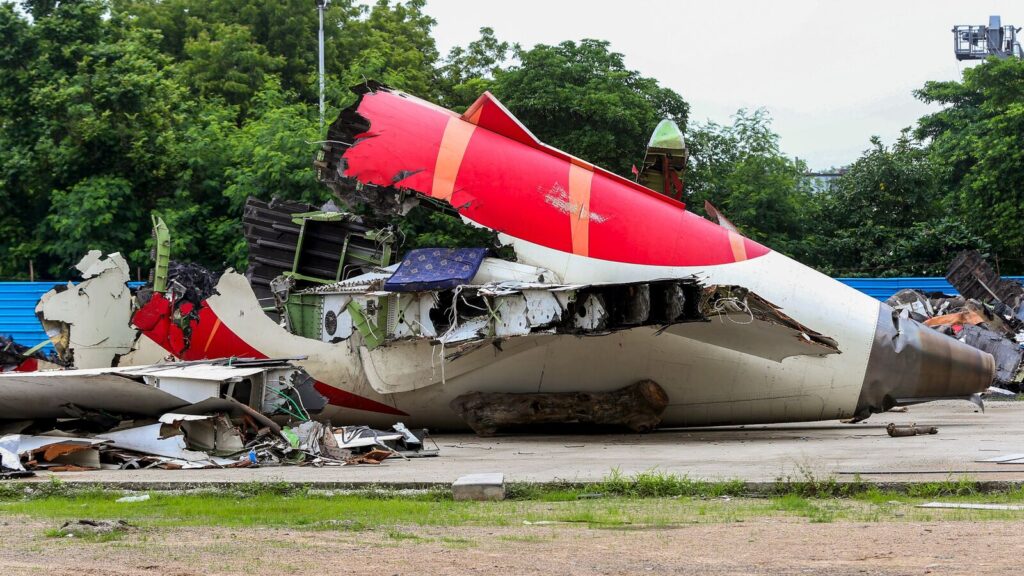The ministry of civil aviation investigators, who analyzed cockpit voice recordings, have found that the 12-year-old Boeing 787 Dreamliner’s fuel control switches transitioned from “RUN” to “CUTOFF” position within one second, causing a sudden power loss, leading to the 12 June accident that claimed 260 lives.
One pilot can be heard asking the other, “Why did you cut off?” To which the other replied, “I did not do so.” The final conversation between the pilots suggests either a malfunction or an involuntary action.
Mint explains what transpired in the cockpit of the London-bound jet.
What happened after takeoff?
The flight received takeoff clearance at 1:37pm IST. According to the flight recorder data, the aircraft crossed the takeoff decision and achieved an airspeed of 153 knots at 1:39pm. The jet achieved the maximum recorded airspeed of 180 knots and started gaining height. After a few seconds, fuel control switches of both engines 1 and 2 transitioned from ‘RUN’ to ‘CUTOFF’ position in 01 second, killing the fuel supply.
What were pilots doing?
In voice recordings retrieved from the black box, one of the pilots is heard asking the other why he cut off the fuel supply. The other pilot responded that he did not do so. At 1:39pm, one of the pilots transmitted a’MAYDAY’ call to air traffic control, but there was no response.
The aircraft started to lose altitude before crossing the airport perimeter wall and crashed into the BJ Medical College.
The airport CCTV footage showed Ram Air Turbine (RAT)—an emergency power source in case of a complete or partial loss of primary power systems— getting deployed immediately after lift-off. RAT uses airflow to generate power to keep essential aircraft systems running.
Did pilots attempt to restart the engines?
The Engine 1 fuel control switch transitioned from ‘CUTOFF’ to ‘RUN’ at about 1:38pm. Within four seconds, the Engine 2 switch also transitioned from ‘CUTOFF’ to ‘RUN’.
The data showed that Engine 1’s core deceleration stopped, reversed, and started to progress to recovery. Engine 2 was able to relight but could not stop the speed deceleration. The data recording stopped at 1:39pm.
The AAIB said that when fuel control switches are moved from ‘CUTOFF’ to ‘RUN’ while the aircraft is in flight, each engine’s full authority dual engine control (FADEC) automatically manages a relight and thrust recovery sequence of ignition and fuel introduction. FADEC is a digital electronic system that manages an aircraft engine’s performance.
Is there an advisory for the use of the fuel control switches?
The US aviation authority, Federal Aviation Administration (FAA), issued a special airworthiness information bulletin (SAIB) in 2018 about the possible disengagement of the fuel control switch locking feature. The SAIB was issued based on reports from 737 MAX aircraft that control switches were installed with the locking feature disengaged.
Did Air India follow the FAA advisory?
Air India told investigators that the fuel control switch design is similar in all Boeing aeroplanes, and the same was fitted in VT-ANB. According to Air India, the suggested inspections were not carried out as the SAIB was “advisory and not mandatory”.
The AAIB’s investigation of maintenance records revealed that the throttle control module was replaced on VT-ANB (Dreamliner) in 2019 and 2023. However, the reason for the replacement was not linked to the fuel control switches. No defect has been reported regarding the fuel control switches on VT-ANB since 2023.
Was the aeroplane well maintained?
All applicable airworthiness directives and alert service bulletins were complied with on the aircraft and engines, according to the AAIB.
The last major line maintenance check, as per the Aircraft Maintenance Programme, was carried out as per schedule. The next major check was due on the aircraft in December 2025.
The left engine was installed on 1 May 2025, and the right engine on 26 March 2025.
What are experts saying?
Mark Martin, chief executive of Martin Consulting, said no pilot would fiddle around with switches in the middle section of the cockpit when all attention is focused on forward flight cockpit instruments located in front of the pilots, during takeoff and landing.
He added that the 787 Dreamliner is a comprehensively digitally controlled and software-driven aircraft that constantly needs patches and system updates. If the fuel switches moved to ‘CUTOFF’, the cause of this trigger needs to be established.
Amit Singh, CEO of Safety Matters Foundation, raised questions on the timeline accuracy and data interpretation on the microblogging site, X.
He highlighted that the RAT was deployed while the aircraft was barely airborne. In a Boeing 787, RAT takes 3-5 seconds after the engine failure to fully get deployed.
He suggested that the engine failure occurred within seconds of lift-off.
What happens now?
Further probe is underway by an investigation team led by Sanjay Kumar Singh of the AAIB. The FAA, US National Transportation Safety Board, UK Civil Aviation Authority, UK NTSB, and Boeing are supporting the investigation.
The team will review and examine additional evidence, records, and information that is being sought from the stakeholders.
At this stage, there are no recommended actions to B787-8 and/or GE GEnx-1B engine operators and manufacturers by the AAIB.

